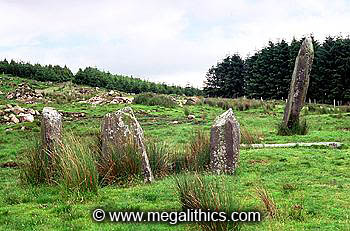
 |
|
Photo Gallery |
|
|
VR Panoramas |
|
| W 297 841 (Pub.) | Diameter 2.7m (approx. Pub.) |
| Visited July 1998 |
Also known as Musherabeg, Muisire Beg, and Cnoc na Cille, this is another complex site containing a two stone row, circle, an Radial-Stone Cairn, it is very similar to Knockraheen and Kealkill. The circle was an Irish five stone recumbent, but only the two northern portal stones and a stone at the west stand today, heights are in the range 1.1 -1.3m. The stone row, comprised of two stones was aligned NE-SW on the circle, the stone nearest the circle has fallen and is 4.2m long, the standing stone has a pronounced lean and is 3.8m tall. About 7m east of the circle is a Radial-Stone Cairn discovered in 1970, it has small, nearly contiguous kerbs, and is around 3.5m in diameter.
Radial-Stone Cairns are quite rare monuments, in 1998 there were only ten known examples in all of Ireland, four of these were in west Cork ( see also Knockraheen and Kealkill). Burl (1), has speculated that these cairns are Irish versions of the Scottish ring-cairns, in Scotland the cairns are edged with a continuous kerb of upright slabs or boulders, whereas in the Cork and Kerry region the cairns have the "kerbs" protruding from their sides "like the ratchets of a cog-wheel". Radial-stone cairns are currently thought to be burial monuments of Bronze Age date (2).
1.
Burl A.
From Carnac to Callanish:
the prehistoric stone rows and avenues of Britian, Ireland and Brittany,
p.192, Yale University Press, 1993,
Newhaven & London.
2.
O'Nuallain S, Journal of the Royal Society of Antiquaries of Ireland, 114, p.63-79, 1984.